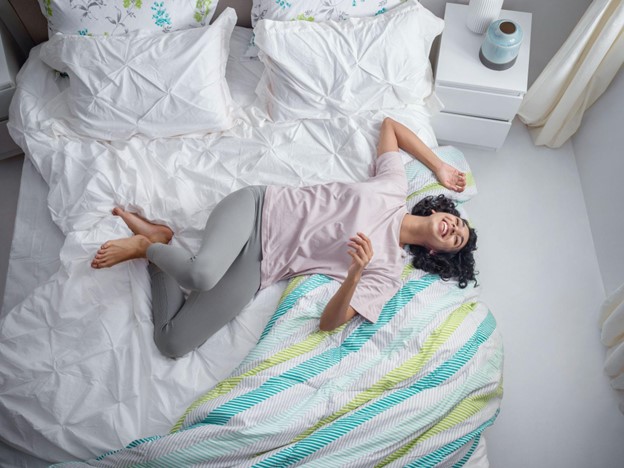Let’s be honest: We don’t often think much about how we sleep. Not until we wake up with pain in the lower back or a neck that feels achy. And most often, how you sleep is the culprit for that nagging pain, apart from what you sleep on, which is your mattress.
It’s easy to overlook the importance of your sleeping position or the mattress you’re sleeping on. That said, when you spend one-third of your life in bed, shouldn’t you make sure that time is well spent? Plus, your mattress isn’t just a place to crash when you come after a gruelling day at work. It’s also where your spine seeks the support it needs after a long day of carrying your body. The wrong mattress, combined with poor sleeping posture, can silently contribute to misalignments, chronic pain, and sleepless nights.
In this blog, we’ll dive into the most common sleeping positions, how they impact your spine, and how to choose the best mattress for spine pain to keep your back in good shape. Let’s dive in:
How sleeping positions impact your spine
It’s true that your spine is a stack of bones called vertebrates. But it’s also the central support structure of your body, playing a key role in how you feel, move, and behave. And the way you sleep directly affects the alignment of this structure. That’s perhaps why sleep experts stress keeping the spine in its natural alignment during sleep. Let’s see how different sleep positions affect your spinal health.
Back sleeping
Sleeping on your back can be one of the best positions for spinal health. It allows your head, neck, and spine to rest in a neutral position, distributing your weight evenly. According to sleep studies, about 38% of people sleep on their backs, making it the second most popular sleep position. If you sleep on your back, you would be better off buying a medium-firm mattress.
Side sleeping
Side sleepers, rejoice! Nearly 54% of people prefer this position, and it’s often recommended for reducing pressure on your spine. If you love the hug of side sleeping, a soft to medium-firm mattress is the best choice as it can cradle their hips and shoulders, preventing misalignment. However, sleeping on your side without the best can cause your spine to sag, leading to morning pain. That’s why you should always get a spine-support mattress, such as the Pro Spintech Series by Sleepwell.
Stomach sleeping
If you sleep on your stomach, your spine is likely arching in all the wrong ways. This position often forces your neck into an awkward position and can strain your lower back. This position makes up only about 7% of sleepers, but unfortunately, it’s the most likely to cause long-term spine issues. If you are tempted to sleep on your tummy, you should definitely have the best mattress for spine health to prevent future pain and discomfort.
Which is the healthiest sleep position?
When it comes to spinal health, not all sleep positions are healthy. Some positions offer excellent spinal support and alignment, while others might leave you waking up with aches and pains. So, if you’re wondering which is the healthiest sleep position, the answer is a bit tricky, but one thing is for sure: stomach sleeping is the worst sleep position of all.
Sleeping on your back is often considered the healthiest position for spinal alignment. Why? Because it allows your head, neck, and spine to rest in a neutral position without unnecessary pressure on any one area. This posture keeps your spine in its natural curve, which means less strain on your back muscles. If you’re prone to lower back pain, this position paired with the best mattress for spine pain can make a huge difference.
Side sleeping is a close second in terms of spinal health as it reduces pressure on your joints and can even help with issues like snoring and acid reflux. However, without a spine-support mattress, your spine can curve unnaturally, especially around the hips and shoulders.
Features to look for in a spine support mattress
Now that we’ve covered the impact of sleeping positions, let’s talk about the mattress features that can keep your spine happy and healthy.
Firmness level
It’s no secret that which mattress you should choose depends on your sleeping position. Back sleepers need a mattress that’s firm enough to support their lower back but soft enough to cradle the spine’s natural curve. Side sleepers should go for a softer mattress that cushions the shoulders and hips. Stomach sleepers, on the other hand, require a firmer surface to prevent their spine from arching unnaturally.
Pressure relief and support
Mattresses made from innovative foam, such as Nexa foam, Rebonded foam, or Impression foam, are excellent for providing both support and pressure relief. They contour to your body and cradle your hips and shoulders, keeping your spine aligned and reducing pressure points that can lead to pain. So, when looking for a mattress for back pain, consider the support and pressure relief it provides.
Motion isolation
If you share a bed with a partner or pet, you would benefit a lot from motion isolation. Mattresses that limit movement transfer, like the Pro Nexa foam or hybrid options, can help you sleep soundly without being jolted awake when your partner tosses and turns.
Orthopedic Support: A Real Lifesaver
If you suffer from back issues or want to prevent them, choosing a mattress with orthopedic features is key. These mattresses are designed with spine health in mind, offering firm support where it’s needed most.
Which spine-support mattress should you choose?
When it comes to choosing the best mattress for spine pain and support, Sleepwell’s Spinetech Mattress stands out as one of the best options available. Whether you’re a back, side, or even a stomach sleeper, this mattress offers a blend of comfort, support, and cutting-edge technology that can help maintain spinal alignment and reduce aches and pains. Sleepwell Pro Spinetech mattress is the recommended and preferred mattress for spine health by the Indian Academy of Orthopaedic Surgeons (IAOS).
The Sleepwell Spinetech Mattress is designed with features that cater specifically to spinal health, ensuring that you wake up feeling refreshed and pain-free. Here are some of the key features that make this mattress a spine-friendly choice
Enhanced firmness
For back and stomach sleepers, the enhanced firmness of this mattress ensures that your spine stays in a neutral position, preventing sinking and maintaining alignment throughout the night.
Medium soft feel
Side sleepers will love the medium-soft feel, which cradles pressure points like the shoulders and hips, allowing for a natural curve without putting unnecessary strain on the spine.
Complete spinal adaptation
The mattress is designed to adapt to your spine, whether you sleep on your back, side, or stomach. This ensures your spine remains supported and aligned, reducing the risk of morning aches.
Dual surface feel
The Spinetech mattress features a dual surface feel, giving you the option to switch between firmness levels depending on your preference, allowing flexibility to adjust to your sleep needs over time. This makes it the best mattress for back pain.
Healthy breathability
Thanks to Sleepwell’s cutting-edge air technology, this mattress offers excellent breathability, keeping your sleep environment cool and promoting air circulation. This is ideal for preventing overheating and ensuring a comfortable night’s sleep.
High resilience layer for comfort
The high-resilience layer adds an extra level of comfort by providing balanced support and responsiveness. This layer helps maintain the mattress’s durability while keeping you comfortable all night long.
Thicker mattress for added comfort
With its thicker design, the Spinetech mattress provides plush support that evenly distributes body weight, preventing pressure points from forming.
Bottom line
Your spine works hard to keep you upright all day, and it deserves a break at night. Whether you’re a back sleeper, side sleeper, or stomach sleeper, there’s a mattress out there that can help you sleep comfortably while supporting your spine.
Don’t wait until the pain starts—invest in a spine support mattress and give your back the care it needs for a healthier, happier you. After all, your spine’s got your back, so make sure you’ve got its back too!





Be First to Comment